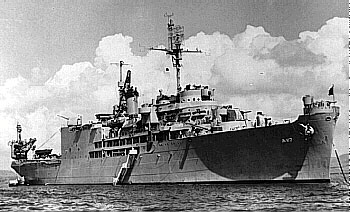
| 2
DEC 46 |
Departed
San Diego, CA. |
| 12
DEC 46 |
Rendezvoused
with USS Henderson and USS
Cacapon near Marquesas Islands, French Polynesia. |
| 24
DEC 46 |
Reached
pack ice near Balleny Islands; first airplane operations were held. |
| 4-5
JAN 47 |
More
mapping flights. |
| 6
JAN 47 |
Proceeded
toward Ross Sea to assist Central Group. |
| 10-11
JAN 47 |
Made
recon flights over the Ross Sea for Central Group. |
| 16
JAN 47 |
Operating
off George V Coast. |
| 25
JAN 47 |
Operating
off Adelie Coast. |
| 1
FEB 47 |
Operating
off Budd Coast. |
| 11
FEB 47 |
Continued
west to vicinity of Shackleton Ice Shelf. |
| 17
FEB 47 |
Operating
off Kemp Coast. |
| 22
FEB 47 |
Operating
off Princess Ragnhild Coast. |
| 28
FEB 47 |
Located
in Prydz Bay. |
| 1
MAR 47 |
Final
flights made in these waters. |
| 3
MAR 47 |
Ship
proceeded north en route to Sydney, Australia. |
| 14
MAR 47 |
Arrived
Sydney, Australia. |
| 20
MAR 47 |
Departed
Sydney, Australia. |
| 9
APR 47 |
Arrived
Balboa, Canal Zone. |
| 18
APR 47 |
Arrived
Norfolk, VA. |
Figure
1

|
Figure
2

|
Figure
3

|
Figure
4
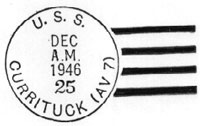
|
Figure
5
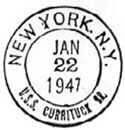
|
Figure
6
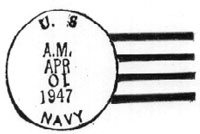
|
Figure
7
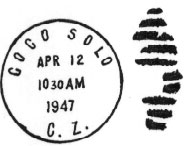
|
Figure
8

|
Figure
9

|
Figure
10

|
Figure
11
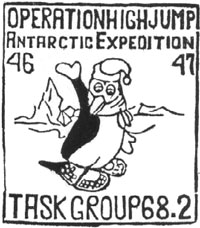
|
Figure
12
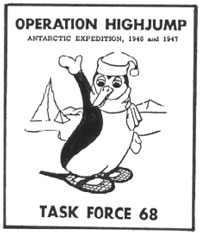
|
Figure
13
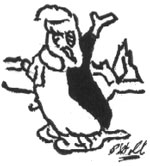
|
Figure
14
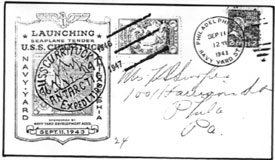
|
Figure
15
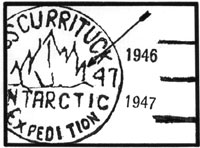
|
Figure
16
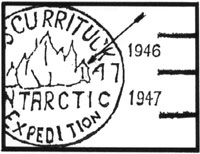
|
USS CURRITUCK
covers are generally found canceled with a homemade pictorial postmark,
of which three varieties are known. Initially, the word "Expedition"
was incorrectly spelled "Expedetion" (figure 1). This is known
on a cover with a 10 January 1947 date. Subsequently, the error was
corrected by cutting off the arms of the "E", making it an
"I". Two types of this "corrected" postmark are
known, the first bearing a month, day and year in the cancel (figure
2), the other variety without specific date, but just the years "1946
/ 1947" (figure 3). Figure three is by far the most widely used
variety of postmark from this ship during OPERATION HIGHJUMP
but several other official types can be found. The standard four-bar
(figure 4), the double-circle all purpose (figure 5) and at least one
known "war-time" issue U.S. Navy four-bar postmark was applied
on April 10 (inverted) 1947 while the ship was at Balboa, Canal Zone
(figure 6). Another cover is known to have received the local postmark
of Coco Solo, Canal Zone on 12 April 1947 (figure 7). These latter two
covers can be identified by the OPERATION HIGHJUMP rubber
stamp cachet and the return address of crewmembers of the Currituck.
Two
different types of return address rubber stamps have been found and
appear confusing until it is explained that the USS CURRITUCK
began OPERATION HIGHJUMP from the western coast of the
United States (figure 8 with San Francisco, California wording) and
returned to a port on the eastern coast (figure 9 with New York, New
York wording). The reason for this being that the ship was to be deactivated
at that time.
Although
of questionable origin, the four-line "ADMIRAL BYRDS / POLAR EXPEDITION
/ USS CURRITUCK AV-7 / 1946-47" handstamp has been found on both
cards and covers to different addresses which would indicate that it
may have been used on board the ship by crewmembers (figure 10).
The
large TASK GROUP 68.2 cachet has been found on the front and reverse
of a number of covers sent by various crewmembers and, in fact, appears
as the letterhead on one known typed letter (figure 11). This cachet
appears to have been inspired by the 'label' applied to another cover
originating on the Currituck (figure 12). Not to be outdone, another
crewmember apparently decided to hand draw his own interpretation of
the penguin in figures 11 and 12, in rough, reverse-image style (figure
13).
This
writer has left a recent discovery (July 1993), made by ASPP'ers
Mark Smith and Murray Fishler, until last for several reasons. Not the
least of these reasons is the fact that this latest variety of the fancy
cancel (shown as figures 1, 2 and 3) appears on a cover cacheted and
canceled in 1943 when the USS CURRITUCK was launched (figure
14). The second reason would be that the writer does not have any explanation
for the appearance of another 'piece' of iceberg in the design. How
did it get there? This cancel was applied quite cleanly to both the
front and reverse of the cover and the iceberg extension is very evident.
Figures 15 and 16 will give the reader a comparison of the two different
iceberg designs. Is there a chance that more than one of these stamps
were made up? Perhaps the readers of this essay will be good enough
to examine their albums and report what they find. Presently, this is
the only usage known to the writer.


